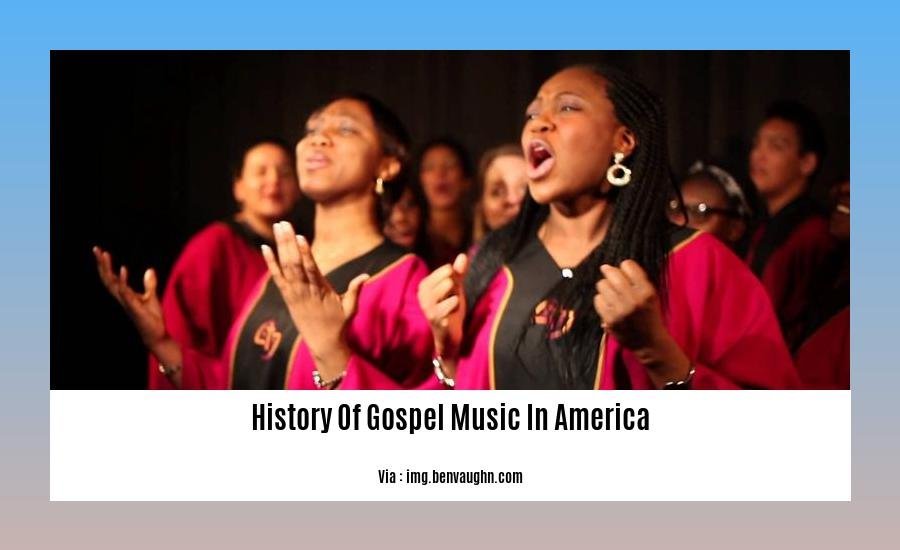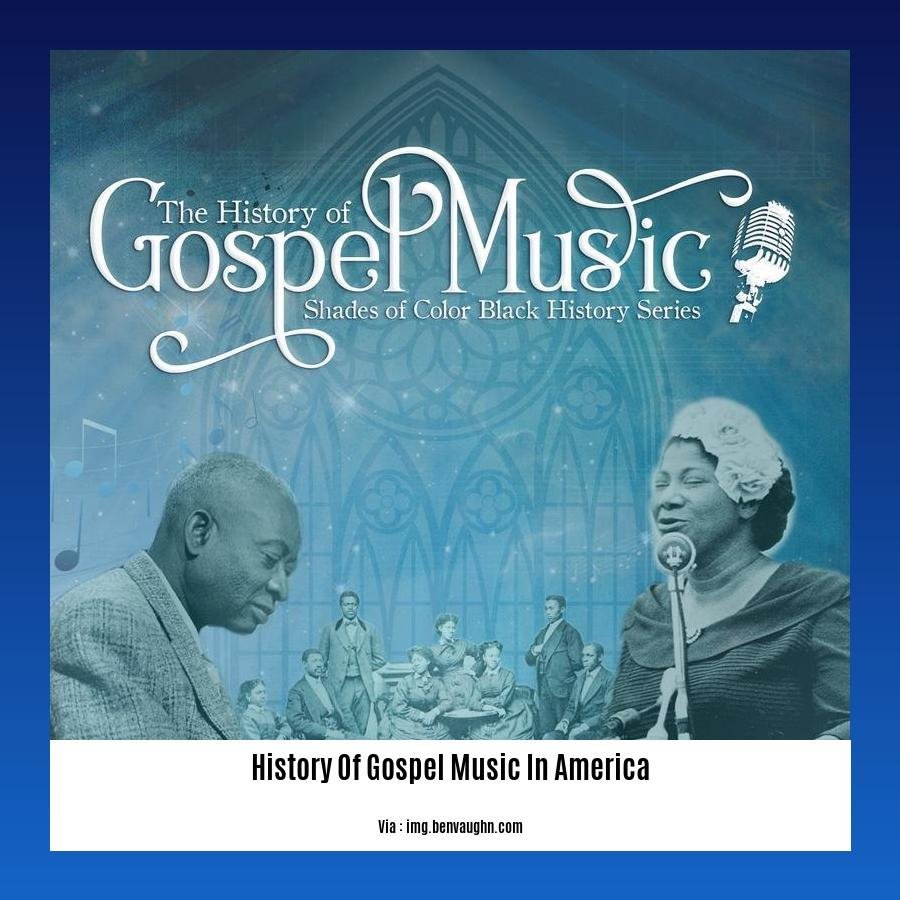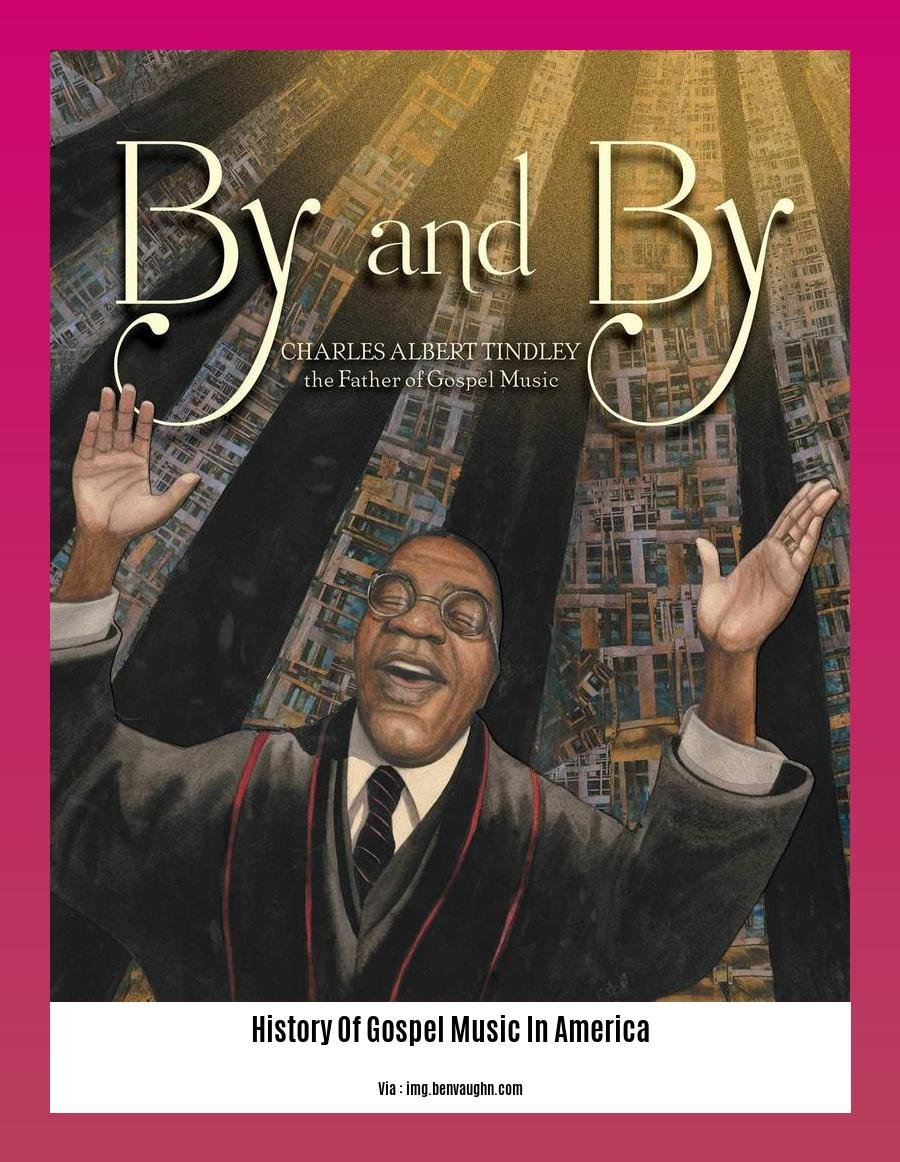Are you ready to embark on a soulful journey through the annals of gospel music in America? In this captivating article, [- The History of Gospel Music in America: From Humble Roots to Chart-Topping Anthems], we’ll explore the evolution of this genre from its humble beginnings to its current status as a global phenomenon.
Key Takeaways:
Gospel music is an American Protestant music genre born from 19th-century religious revivals.
There were two different directions of gospel music among white and Black American communities.
White gospel music developed in the late 19th and early 20th centuries and incorporated country, folk, and rural Protestant hymnody elements.
Black gospel music originated in Black American hymnody and spirituals and emerged as a distinctive genre in the early 20th century by incorporating jazz, blues, and sanctified singing.
Notable white gospel music artists include George Beverly Shea, Hovie Lister, and Ira D. Sankey.
Notable Black gospel music artists include Thomas A. Dorsey, Mahalia Jackson, and Andraé Crouch.
History Of Gospel Music In America

Gospel music, a genre deeply rooted in American Protestant culture, has a rich and captivating history. Its journey, spanning centuries, showcases its profound impact on American music and society.
Humble Beginnings: The 19th Century
The roots of gospel music can be traced back to the fervor of Protestant revivals in the 19th century. White and Black American communities, though sharing the gospel’s message, diverged in their musical expressions. White gospel music drew inspiration from country, folk, and rural Protestant hymnody, with artists like George Beverly Shea and Hovie Lister gracing the scene. Concurrently, Black gospel music emerged from the depths of Black American hymnody and spirituals, influenced by jazz, blues, and sanctified singing. Thomas A. Dorsey, Mahalia Jackson, and Andraé Crouch stand as towering figures in the genre’s early years.
The 20th Century: A Gospel Renaissance
The 20th century witnessed a remarkable transformation in gospel music. It transcended the confines of the church, captivating audiences far and wide. Radio stations dedicated to gospel music sprang up, providing a platform for artists to share their soul-stirring melodies with the masses. The rise of gospel quartets and choirs further propelled the genre into the limelight, igniting a flame of enthusiasm that continues to burn brightly.
Gospel’s Enduring Legacy
Today, gospel music remains a vibrant and integral part of American culture. It has transcended its religious roots, becoming a genre celebrated for its artistic merit, emotional depth, and unifying power. Gospel music has left an indelible mark on popular music, influencing soul, R&B, and even hip-hop. Artists like Aretha Franklin, Elvis Presley, and Kanye West have all drawn inspiration from this genre, paying homage to its rich heritage.
Conclusion: A Tapestry of Faith and Melody
The History Of Gospel Music In America is a testament to the enduring power of faith and melody. It is a story of humble beginnings, triumphant ascents, and the unwavering spirit of the human voice raised in song. As gospel music continues to evolve, its legacy lives on, inspiring and uplifting generations to come.
Learn about the evolution of gospel music through the ages by delving into the history of gospel music.
Discover the pivotal moments and influential figures that shaped the genre in the history of gospel music timeline.
Immerse yourself in the captivating history of gospel music documentary to witness the transformative impact of gospel music firsthand.
Unravel the intricate relationship between history of gospel music and slavery and how it shaped its distinctive sound and message of hope.
Explore the rich tapestry of history of gospel music in Nigeria and its vibrant contributions to the global gospel music landscape.
Development of Distinct Styles and Subgenres

The gospel family tree is sprawling and diverse, with branches reaching into every corner of American music.
The genre’s rich tapestry of styles and subgenres is a testament to its enduring power and adaptability.
Key Takeaways:
- Gospel music has four main styles: traditional, contemporary, quartet, and urban contemporary.
- Traditional gospel is rooted in the African American church and features strong vocals, passionate lyrics, and a focus on religious themes.
- Contemporary gospel is a more modern style that incorporates elements of R&B, soul, and funk.
- Quartet gospel is a style of gospel music that is typically performed by a group of four singers, accompanied by piano, bass, and drums.
- Urban contemporary gospel is a style of gospel music that is influenced by hip-hop, soul, and R&B.
Four Pillars of Gospel Music
In the 1930s, during what’s known as gospel’s “Golden Age,” four main styles emerged:
Traditional Gospel: Imagine powerful vocals soaring over a foundation of piano, organ, and drums, lifting spirits with heartfelt lyrics that draw from the African American spirituals of old.
Contemporary Gospel: Get ready for a vibrant blend of R&B, soul, and funk, infused with gospel’s uplifting message. This style captivates audiences with its infectious rhythms and soulful melodies.
Quartet Gospel: Visualize a tight-knit group of four singers, their voices harmonizing like angels, backed by the steady pulse of piano, bass, and drums. Quartet gospel is a testament to the power of unity and shared faith.
Urban Contemporary Gospel: This electrifying style fuses gospel’s core elements with hip-hop, soul, and R&B beats. Urban contemporary gospel is a reflection of the genre’s ability to stay relevant and relatable to modern audiences.
The Unifying Power of Gospel
Despite their differences, these styles share a common thread: a deep reverence for faith and a commitment to spreading its message through music.
Whether it’s the soul-stirring melodies of traditional gospel, the energetic beats of contemporary gospel, the heartfelt harmonies of quartet gospel, or the urban flair of urban contemporary gospel, each style has its unique way of touching hearts and inspiring souls.
The enduring legacy of gospel music is a testament to its power to uplift, unite, and bring people together in celebration of their shared faith.
Sources
Impact on American Culture and Social Movements
Gospel music, rooted in the African American church, has played a significant role in shaping American culture and social movements. It’s a vibrant tapestry of sounds and emotions, a testament to resilience and hope. Let’s explore this genre’s profound Impact on American Culture and Social Movements.
Key Takeaways:
Gospel music emerged as a beacon of hope for enslaved people during the era of slavery, providing solace and resilience amidst adversity.
It has been a catalyst for social change, playing a pivotal role in the Civil Rights Movement. Gospel songs became anthems of unity and resistance, galvanizing people to fight for their rights.
Gospel music transcended racial and cultural boundaries, becoming a unifying force that brought people together from diverse backgrounds.
Notable gospel artists like Aretha Franklin, Mahalia Jackson, and Kirk Franklin have used their music to uplift spirits, inspire change, and spread messages of love and hope.
Gospel music’s influence extends beyond religious circles, influencing popular music genres like R&B, soul, and rock n’ roll. It has shaped the soundtracks of our lives and continues to captivate audiences worldwide.
Citation:
The Impact Of Gospel Music On American Culture | Ben Vaughn
Gospel Music Today: Contemporary Trends and Influences
Today’s gospel music is a dynamic and ever-evolving genre, reflecting the rich tapestry of American culture and the ever-changing landscape of the music industry. Contemporary gospel music draws inspiration from a wide range of musical styles, including traditional gospel, R&B, soul, and even hip-hop, creating a vibrant and diverse soundscape that resonates with audiences of all ages and backgrounds.
Key Takeaways:
Gospel music has undergone a remarkable transformation, becoming more diverse and inclusive, resulting in a genre that reflects the changing face of the modern world.
Contemporary gospel music seamlessly blends traditional gospel elements with modern musical influences, appealing to a broader audience and bridging the gap between sacred and secular music.
The use of technology has revolutionized the way gospel music is created, distributed, and consumed, making it more accessible to a global audience.
Gospel music continues to play a vital role in empowering communities, addressing social issues, and providing solace and inspiration during challenging times.
Contemporary gospel music is often characterized by its powerful vocals, energetic rhythms, and uplifting lyrics that speak to themes of faith, hope, and perseverance. Artists are pushing the boundaries of the genre, experimenting with new sounds and incorporating elements from other musical traditions. This blend of old and new has resulted in a vibrant and dynamic genre that is both rooted in tradition and open to innovation.
The rise of technology has also significantly impacted contemporary gospel music. Social media platforms and online streaming services have made it easier for artists to reach a global audience, while also providing opportunities for collaboration and the sharing of ideas. Additionally, the use of digital tools and software has transformed the way gospel music is produced and recorded, allowing artists to create high-quality recordings with limited resources.
Contemporary gospel music continues to be a powerful force for good in the world. It has played a crucial role in addressing social issues, such as racial injustice, poverty, and inequality. Through its message of hope and resilience, gospel music has provided solace and inspiration to countless individuals during challenging times. Additionally, the genre has been instrumental in empowering communities and fostering a sense of unity and belonging.
Relevant URL Sources:
Gospel Music: How It Got Here and Where It’s Going
FAQ
Q1: What are the main characteristics of gospel music?
A1: Gospel music is characterized by its strong vocals, passionate lyrics, and focus on religious themes. It often incorporates elements of African-American spirituals, blues, and jazz.
Q2: How did gospel music originate?
A2: Gospel music originated in the 19th century within African-American churches. It emerged from the spirituals sung by enslaved people and their descendants and was influenced by various musical styles, including blues, jazz, and traditional hymns.
Q3: What are the different styles of gospel music?
A3: There are four main styles of gospel music: traditional gospel, contemporary gospel, quartet gospel, and urban contemporary gospel. Each style has its own unique characteristics and musical influences.
Q4: What role did gospel music play in the Civil Rights Movement?
A4: Gospel music played a significant role in the Civil Rights Movement. It served as a source of inspiration and unity for African Americans during the struggle for equal rights. Gospel songs were often used to convey messages of hope and resilience and to mobilize people to action.
Q5: Who are some notable gospel artists?
A5: Some notable gospel artists include Mahalia Jackson, Thomas A. Dorsey, Andraé Crouch, Kirk Franklin, and Aretha Franklin. These artists have helped popularize gospel music and spread its message of hope and inspiration worldwide.










